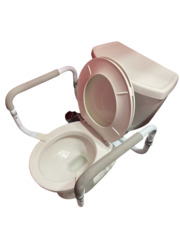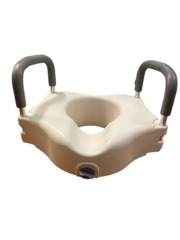¶ Introduction
Toileting refers to the act of having a bowel movement or urinating into a suitable receptacle.
Muscle weakness caused by ALS affects the ability to get to a toilet, both in general, and in a timely manner. Adaptive equipment and alternative approaches can aid in toileting.
¶ Types of Toilets
| Term | Definition |
|---|---|
| Bedpan | A shallow container used to urinate or defecate while lying down. |
| Commode Chair | A portable toilet, often resembling a chair, often with a removable container for catching waste. |
| Flush Toilet | A plumbing fixture that disposes of human waste by using water to flush it through a drainpipe to a sewer or septic system. |
| Urine Bottle | A portable container used for urination. |
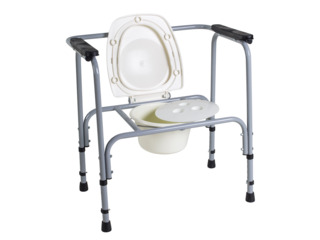
A bedside commode chair.
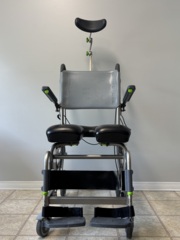
A wheeled tilt shower commode chair, front view.
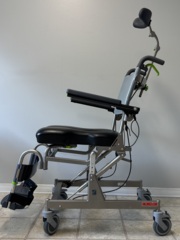
A wheeled tilt shower commode chair, side view, upright.
¶ Seat Height
Toilets come in different seating heights. While there are height measurements that are quite common, toilets may be installed at any height.
Ideally, a person's knees would be higher than their hips when sitting on a toilet. Such a position helps with evacuation.
Lower limb weakness necessitates the use of a toilet with a higher seating position, as low seating positions require significant strength to stand up from. Further disease progression will require ever-higher seating heights, until it becomes impractical to stand independently from any height.
Toilet seat risers or over-the-toilet commode chairs (with or without wheels) can be used to increase the seating height of a flush toilet.
Toilet safety rails may be useful if the toilet itself already has a relatively high seating position.
¶ Getting to a Toilet
Flush toilets are typically mounted near walls; this necessitates either a turn in order to reach them before sitting down, or in some cases, walking backwards for a few steps. These maneuvers are difficult and potentially unsafe for someone with significant ALS disease progression.
Grab bars and transfer poles may be used to provide support while walking backward to a toilet if the individual retains a moderate amount of lower limb strength.
Wheeled over-the-toilet commode chairs may be used to complete the journey to the toilet if the layout of the bathroom permits. Care should be taken to avoid ramming the commode chair into the toilet tank, as it may cause it to crack and leak water.
It may not be possible to transport the commode chair to a toilet in some cases. Most commode chairs can be fitted with a pan that catches waste, which can then be thrown out or flushed down a toilet.
¶ Examples
The following are examples of getting to a flush toilet.
Example 1: Moderate disability with walking and standing
Adaptive equipment:
- walker
- grab bar
- toilet seat riser, or over-the-toilet commode chair
Steps:
- Walk as close to the toilet as possible with the walker
- Use a wall-mounted grab-bar for support to turn around
- Slowly sit down upon the toilet, which has been fitted with a toilet seat riser or commode chair to increase its height
Example 2: Significant disability with walking and standing
Adaptive equipment:
- floor lift
Steps:
- Using a floor lift, transfer from the point of origin directly to the toilet
Example 3: Significant disability with walking and standing, alternate approach
Adaptive equipment:
- wheeled over-the-toilet commode chair
- floor lift, or ceiling lift
Steps:
- Using a patient lift, transfer to a wheeled over-the-toilet commode chair
- Have an assistant push the commode chair over top of the toilet bowl
- Align the commode chair carefully, and set the brakes
¶ Sitting on a Toilet
Sitting on a toilet for a prolonged length of time requires sufficient trunk strength to maintain stability. Those with significant muscle wasting in their gluteus muscles may become sore from sitting on a rigid toilet seat.
A padded toilet seat or a commode chair with a padded seat increases comfort.
Commode chairs with a back rest, lumbar, and leg supports on the sides provide support when trunk strength is low.
¶ Alternate Methods of Toileting
When it is not possible or practical to get to a toilet due to disability or incontinence, the patient may use a combination of briefs and a catheter, or a bedpan and urine bottle.
¶ Anal Hygiene
¶ Toilet Paper
🚧
¶ Bidets
🚧
¶ Waste Disposal
Human waste that is not being disposed of in a flush toilet will need to be disposed of according to the regulations of the municipal waste program. Some jurisdictions require signing up for a diaper removal program, which may have associated fees and require periodic renewal.
The waste disposal container should be at least 10 gallons (38L) in size if it is to be collected weekly.
¶ Public Bathrooms
🚧
